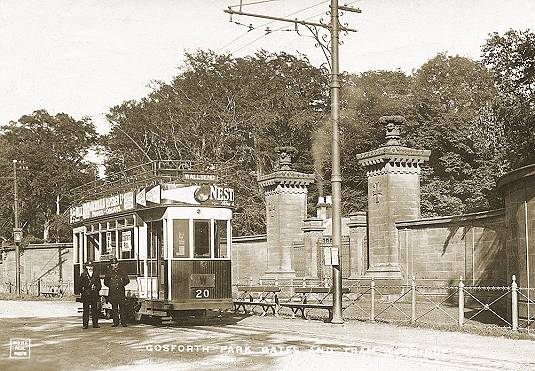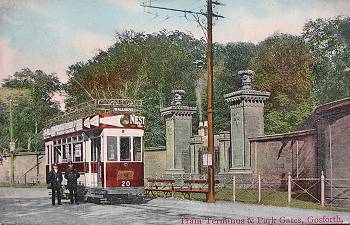

This photographic sepia postcard shows car no. 20 on a summer's afternoon at Gosforth Park Gates (the West Gates), the northernmost terminus of the Tyneside Tramways and Tramroads Company (TTT). The photo was taken in about 1912 by G.F.Lee of Gosforth and the card was posted by 'Winnie' from Newcastle-upon-Tyne to another 'Winnie' at Gateshead on 31 July 1917 (coincidentally, the day the Battle of Passchendaele, east of Ypres, started in Flanders during WW1).
Gosforth is immediately north of Newcastle in the north-east of England and the TTT company officially opened its tramways on 29th September 1902 (although there had been some partial workings a few days earlier), almost a year after Newcastle Corporation had opened its own electric tramways. Both used standard gauge. These had been preceded by a horse tramway in the area operated by the Newcastle & Gosforth Tramways & Carriage Co. Ltd. from 1878 until 1901.
The TTT company operated its services from Gosforth, south-eastwards to Wallsend, by-passing most of Newcastle, and further east to North Shields. A particular feature of the Gosforth to Wallsend section was the use of some 3 miles of cross-country line, on reserved track away from public roads, that used an old wagonway of Coxlodge Colliery. The first two miles of route south from Gosforth Park Gates were on the Great North Road before turning on to the tramroad for the journey to Wallsend. The TTT company closed its tramways on 6 April 1930 but only had about 11 miles of its own track and shared another 5 miles or so with Newcastle Corporation. Upon closure, the Gosforth tracks on the Great North Road were taken over by Newcastle Corporation Tramways and used until 1948, although the city's tram system didn't finally close until 1950.
Tram no. 20 was an open-top, four-wheel car built by Brush in 1904 as one of a batch of four, numbered 19-22. It seated 24 downstairs and 41 upstairs and was mounted on a Brill 21E truck powered by two 40hp Westinghouse 80 motors and operated by Westinghouse controllers. In our scene, the tram is ready for the return journey to Wallsend, as shown both by the destination box and the large 'W' fixed to the dash panel. A poster in the centre window tells us that the return fare was 5d (= 2 pence today). Unusually, the dash was constructed with vertical wood panels and the headlamp was mounted on the upper deck ends rather than on the dash panel. It was also unusual for the period in that all of TTT's early trams built in 1902 and 1904 had enclosed platforms from new, although they were all open-toppers.
 The fleet had 29 or 30 trams at maximum strength, from a variety of builders. The livery was dark green and cream, but in a coloured version of this same postcard, left, it is depicted as red. This is a useful reminder that early picture postcards should not be relied on for tram liveries because monochrome photography was used for the base image and the colours were added at the printing stage. We suspect that the publisher here has confused this tram with one of the nearby Tynemouth & District Electric Tramways which were indeed crimson lake and cream.
The fleet had 29 or 30 trams at maximum strength, from a variety of builders. The livery was dark green and cream, but in a coloured version of this same postcard, left, it is depicted as red. This is a useful reminder that early picture postcards should not be relied on for tram liveries because monochrome photography was used for the base image and the colours were added at the printing stage. We suspect that the publisher here has confused this tram with one of the nearby Tynemouth & District Electric Tramways which were indeed crimson lake and cream.
In 1924, an approximately two-mile long extension was built north from this terminus to the racecourse and then looped to the east, joining the existing Newcastle system at Benton. This picturesque section was known as the Gosforth Park Light Railway, appropriate enough as over a mile of it was on private reserved track. This route was mostly operated by Newcastle Corporation trams which had operating rights over the Gosforth tracks. The TTT company also had reciprocal running rights over Newcastle's tracks into the city centre.
Much later, Newcastle's trolleybuses operated from Gosforth Park Gates down to the city centre until abandoned by 1966 in favour of the ubiquitous motor bus.
![]() Go to Postcard Of The Month Index
Go to Postcard Of The Month Index